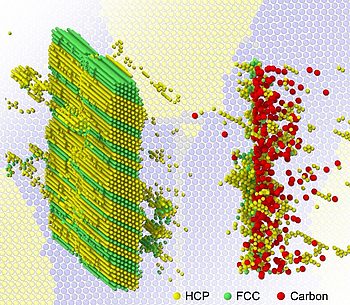Atomistic simulations of pressure-induced phase transformation in ferrous alloys
Materials under high pressure conditions change their microstructure, electrostatic interactions and chemical bonding. In particular, the high-pressure phase of iron has been studied in detail as it is ubiquitous in many fields from geophysics to engineering. Iron exhibits a pressure-induced phase transformation from the body-centered cubic to the hexagonal closest packed phase at about 13 GPa. However, the role of interstitial and alloying elements in the pressure-induced transformation process and the influence of magnetism on the interaction between plasticity and phase transformation are still unclear. In particular, the role of hydrogen in the transformation is open, although the transformation in hydrogen-loaded samples is accompanied by drastic changes in unit cell volume. Therefore, one aim of this project is to investigate the effects of the interstitial elements hydrogen and carbon in iron by molecular dynamics simulations to explain important morphological changes such as hydrogen embrittlement. In addition, we will analyze the magnetic structure during the pressure-induced transformation to describe the deformation and transformation properties based on the magnetic structure.
The DFG project “Atomistic simulations of pressure-induced phase transformation in iron alloys” has been approved for a period of 3 years in the Computational Material Sciences/Engineering working group headed by Professor Nina Merkert. The project has a budget of around 370,000 euros.

Nucleation of hcp at defective iron: edge dislocation (left), Cottrell atomsphere (right)